Whether your child needs a multi-use mountain bike for neighborhood and trail riding, or a rig to tackle more technical trails, there is a lot to consider when shopping for a 20 inch mountain bike. Mountain biking is one of those sports in which investing in quality products can make a huge difference in performance, but how much “bike” does your little one actually need?
What makes a 20 inch mountain bike excel can be VERY different from what makes an adult bike, or even a larger kids mountain bike great. Super slack bikes with suspension forks, dropper posts, and large cassettes may be killer on your bike, but unnecessarily weigh down young, lightweight riders on 20 inch bikes.

So what makes an exceptional 20″ MTB? It all comes down to finding the right bike for your child’s ability, for their riding style, and for your budget. Having tested over 50 different 20 inch bikes, in this article we’ll outline what to look for when shopping for a 20 inch mountain bike (click to jump down to that section) as well as walk you through our favorite models at various price points.
Best 20 inch Mountain Bikes
| Bike | Why It Stands Out | MSRP |
|---|---|---|
| Beginning 20 Inch Mountain Bikes - Quality geared bikes with knobby tires for basic trails | ||
| Polygon Premiere | Lightest bike under $300 by 4 lbs! | $239 |
| Prevelo Alpha Three | Exceptionally nimble, wide gear range | $569 |
| Rigid Trail Bikes for Progressing Riders - Trigger shifters, disc brakes, 7+ gears, rigid fork | ||
| Commencal Ramones 20 | Great components, geometry for the price | $480 |
| Pello Rover | Versatile for on and off the trail | $589 |
| woom OFF 4 | Lightest legit MTB on the market! | $849 |
| Front Suspension Bikes for Progressing Riders - Trigger shifters, disc brakes, 8+ gears, air fork | ||
| woom OFF AIR 4 | Super light weight MTB with air fork | $999 |
| Prevelo Zulu Three | Aggressive trail geo, 10 gears, 80 mm fork | $999 |
| Commencal Meta HT | 100mm travel, SRAM 10 speed, Maxxis tires | $1500 |
| Trailcraft Blue Sky 20 | Most lightweight, customizable high-end builds | $1899 |
| Bikes We DON'T RECOMMEND for True Mountain Biking | ||
| REI Co-op REV 20 Plus | Heavy with basic components | $399 |
| Trek Precaliber 20 | Heavy for its price | $399 |
| Specialized Riprock 20 | Geometry too aggressive for most riders | $599 |
PROPER BIKE SIZING: Please note that although all of these bikes have 20″ wheels, they vary greatly in size. Be sure to take note of the bike’s minimum seat height (listed in descriptions below). In order to properly fit on a bike your child’s inseam needs to be 2″ to 3″ below the bike’s minimum seat height.
BASIC 20 INCH MOUNTAIN BIKES – Beginning Riders
While suspension forks, trigger shifters, and hydraulic disc brakes are essential for adult mountain bikes, they certainly aren’t required for young riders just getting started on basic trails.
Beginning riders (especially those on 20 inch mountain bikes) simply don’t weigh enough for a reasonably-priced suspension fork to work properly. Beginners also don’t travel at the same high velocities as adults, and thus don’t need the extra stopping power of hydraulic disc brakes.
So for kids just getting started on basic trails, what features do you need to get rolling without breaking the bank?
- Durable, lightweight frame
- Powerful, dual handbrakes
- Easy-to-use gears
- Knobby tires
How much do I need to spend on a bike? Spend as much as your budget will allow, but be careful not to “over buy”. If your young rider is truly a beginner and you only plan to ride basic trails, any of these bikes in this beginners section should suit them just fine.
While the higher-priced bikes on this list do offer better components and an overall better riding experience than lower-priced bikes, you don’t need to spend $800 on a bike to start enjoying the trails.
Polygon Premiere Ultralight or XC
Lightest bike under $300, Nimble and Fast with Optional Coil Fork
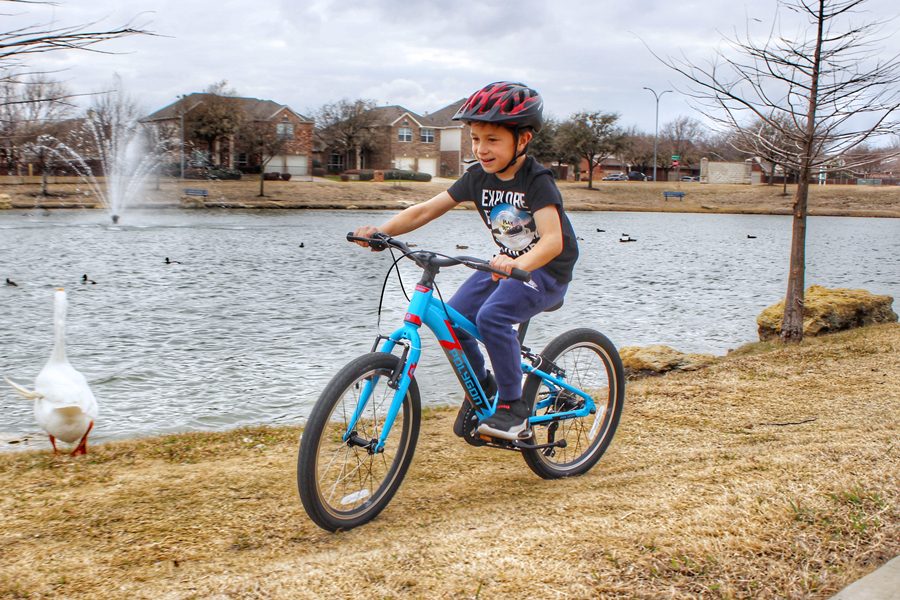
The Polygon Premier is available in two models – the Ultralight and the XC. The bikes share the same frame and drivetrain, but the Ultralight has a rigid fork with all-terrain tires while the XC has a suspension fork and wider off-road tires.
| Premier Ultralight | Premier XC | |
| MSRP | $239 | $260 |
| Weight | 20.75 lb. | 22.6 lb. |
| Seat Height | 21.25″ – 27.25″ | 22″ – 27.5″ |
| Tire Width | 1.75″ | 2.0″ |
| Max Tire Width | 2.1″ | 2.1″ |
| Gearing | 6 speed, grip | 6 speed, grip |
| Brakes | V-pull | V-pull |
| Fork | Rigid | 40 mm Suntour Coil |
| Head Tube | 69° | 69° |
| Seat Tube | 72° | 72° |
Offering the perfect mix of not “too basic”, yet not “too technical”, Polygon’s Premier bikes provide the lightweight nimbleness young riders needs along with sufficient technical brawn to help them confidently tackle trails.
While the Ultralight is designed as a multi-use bike for riding on pavement and compact dirt trails, we found its lightweight build and quality brakes to also be suitable on basic single track. For frequent trail riding, we would swap out the Ultralight’s 1.75″ wide all-terrain tire with a 2.0″ wide off-road, knobby tire.
For kids ready to regularly take on trails from the get-go, the Premier XC comes with 2.0″ knobby tires as well as a 40mm Suntour coil fork. While these upgrades certainly make the XC more capable on dirt, they do add almost 2 pounds of weight to the bike.
For aggressive riders or larger-framed kids, the extra two pounds may be worth the upgrade, but for timid or more petite riders, we would recommend going with the rigid Ultralight and upgrade the tires.
COMPLETE REVIEW: Polygon Premiere Ultralight
Prevelo Alpha Three
Lightest Multi-use Bike on the Market, Trigger Shifters with 8 gears

| Prevelo Alpha Three | ||
| MSRP | $569 | |
| Weight | 18.4 lb. | |
| Seat Height | 21″ – 26″ | |
| Tire Width | 1.5″ | |
| Max Tire Width | 2.1″ in front and back | |
| Gearing | 9-speed trigger | |
| Brakes | Tektro v-pull | |
| Fork | Rigid | |
| Head Tube | 69° | |
| Seat Tube | 71.5° |
COMPLETE REVIEW: Prevelo Alpha Three
Although the Prevelo Alpha Three is designed as an all-purpose bike, it truly excels as a beginning mountain bike for young riders hitting basic trails. Ridiculously lightweight and nimble, the Prevelo Alpha quickly builds confidence in budding trail riders.
With a low center of gravity frame paired with a wide 560mm bar, the Alpha seamlessly glides in and out of turns without skipping a beat. To help little legs take on big challenges, the Alpha provides plenty of climbing power with 8 gears that span a wide gain ratio range. Its Microshift trigger shifter was designed specifically for kids, and is one of the easiest to engage.
With the Alpha’s most recent update, it’s now compatible with tires up to 2.1″ wide. We’re stoked about this design change as wider tires can provide more cushioning and traction as kids step up their MTB game.
20 INCH MOUNTAIN BIKES – Intermediate and Advanced Riders
If intermediate blue trails are in your child’s future, a more advanced and capable 20 inch mountain bike can greatly increase their enjoyment, performance, and even their safety while on the trail.
In addition to the quality of build, the four main components that differentiate most “beginning” bikes from “intermediate or advanced” bikes are:
(1) more aggressive geometry (slacker head tube angles)
(2) wide, cushioning tires
(3) powerful and responsive disc brakes
(4) optional suspension fork
The bike that is best for your child really comes down to how they plan on using it. For shuttle and lift assist rides, a couple extra pounds added to the bike for the suspension fork will quickly pay dividends. On the flip side, those extra pounds are quickly going to slow down a young rider who is likely already struggling on the climbs.
If you aren’t sure, take note of what aspect of riding your child is currently (or is likely to), complain about the most. If climbing is where they really struggle, a lightweight rigid bike with a less slack headtube angle will go a long way in helping them become a better climber with time (although you may still have to tow them up steep or long climbs). If they complain more about being bounced around on the bike and their arms and hands getting tired, then a bike with a quality suspension fork is likely in order.
Regardless of whether you go with a suspension fork or not, be mindful of headtube angles. The slacker Prevelo Zulu with a 66° headtube angle offers amazing confidence-building stability on the downhill, but the 69.5° head tube angle of the Pello Rover is going to excel on the climbs. Considering that the 10,000+ ft. Wasatch mountain range in Utah is our main testing ground, we’ve found it better to give preference to the uphills, but that certainly may not be the case for your area or riding style.
Commencal Ramones 20
Great Components and Geometry for the Price

| Commencal Ramones 20 | ||
| MSRP | $480 | |
| Weight | 23.5 lb. | |
| Seat Height | 24″ – 28″ | |
| Tire Width | 2.6″ | |
| Max Tire Width | 2.6″ | |
| Gearing | 7-speed trigger | |
| Brakes | Mechanical disc | |
| Fork | Rigid | |
| Head Tube | 69° | |
| Seat Tube | 73° |
COMPLETE REVIEW: Commencal Ramones (24″, we haven’t tested the 20″)
Redesigned for 2022, the new Commencal Ramones 20 is more trail-ready than ever before. With mechanical disc brakes, trigger shifters, and wide, knobby tires, the Ramones is one of our favorite options for families on a budget.
The biggest difference you’ll find by increasing your budget is that mountain bikes weigh less at higher price points. But at this price point, the Ramones is lighter than other bikes. And for kids this age, a few pounds can make a huge difference, especially when climbing!
woom OFF and OFF AIR
Ridiculously Lightweight, Exceptional All Mountain Performance, Optional 60mm Air Fork
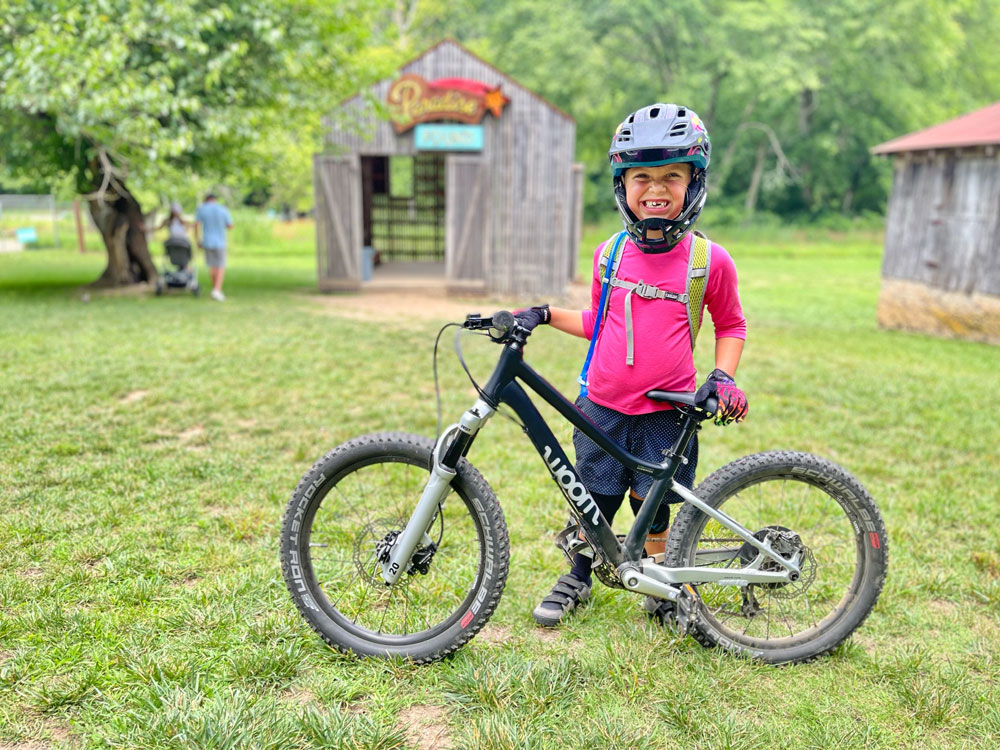
The only differentiator between the woom OFF and the woom OFF AIR is the suspension fork. The air fork on the OFF AIR is built specifically for young, lightweight kids and has 60 mm of travel with adjustable rebound and lockout. woom’s air fork can also be purchased separately for an upgrade later if needed.
| OFF 4 | OFF AIR 4 | |
| MSRP | $849 | $999 |
| Weight | 18.5 lb. | 21 lb. |
| Seat Height | 22.8″ – 28.7″ | 22.8″ – 28.7″ |
| Tire Width | 2.35″ | 2.35″ |
| Gearing | 9 speed, SRAM trigger | 9 speed, SRAM trigger |
| Brakes | Hydraulic disc | Hydraulic disc |
| Fork | Rigid | 60 mm Air fork with rebound |
| Head Tube | 68° | 68° |
| Seat Tube | 70° | 70° |
COMPLETE REVIEW: woom OFF 4 or woom OFF AIR 4
If money were no object (but clearly it is – especially in the high-end bike world!!), we would recommend every little newbie grom to start their mountain bike journey on a woom OFF 4 – especially those kids tackling hills. Why? Because 4 to 7-year-olds on a 20 inch mountain bike weigh next to nothing. So in order for a bike to work with their small bodies, it needs to be really light.
For example, if a 5-year-old weighs 50 pounds, a 22 pound bike (while very light!) still weighs 44% of their body weight. At 18.5 pounds, the woom OFF would only be 37% of that child’s body weight.
Can you imagine hauling a bike 44% of your body weight up a hill? To top that off, 4 to 7-year-olds don’t have the mental or physical stamina to endure long rides or climbs, so they need all the help they can get!
In addition to being light, the woom OFF has the complete package of hydraulic disc brakes, SRAM trigger shifters, and 2.25″ wide cushioning, off-road tires. For the beginning to intermediate rider, the woom OFF is the perfect pony for developing their skills.
When should you upgrade to the woom OFF AIR? If your little ripper is all about catching air, or if you plan on doing lift-assisted or shuttled rides, the AIR is certainly worth the upgrade. While the additional 2.5 pounds the suspension fork adds is noticeable, as long as your child spends more time pointed downhill than uphill, the suspension fork is worth the added investment. (The only 20″ hardtail that is lighter is the Trailcraft Blue Sky 20.)
For those who need extra cushioning on chunky trails, while front suspension can be beneficial, simply lowering the PSI on the front tire will provide a similar cushioning effect but without the added weight and expense.
Pello Rover
Fully Capable, Lightweight Rig at a Great Price
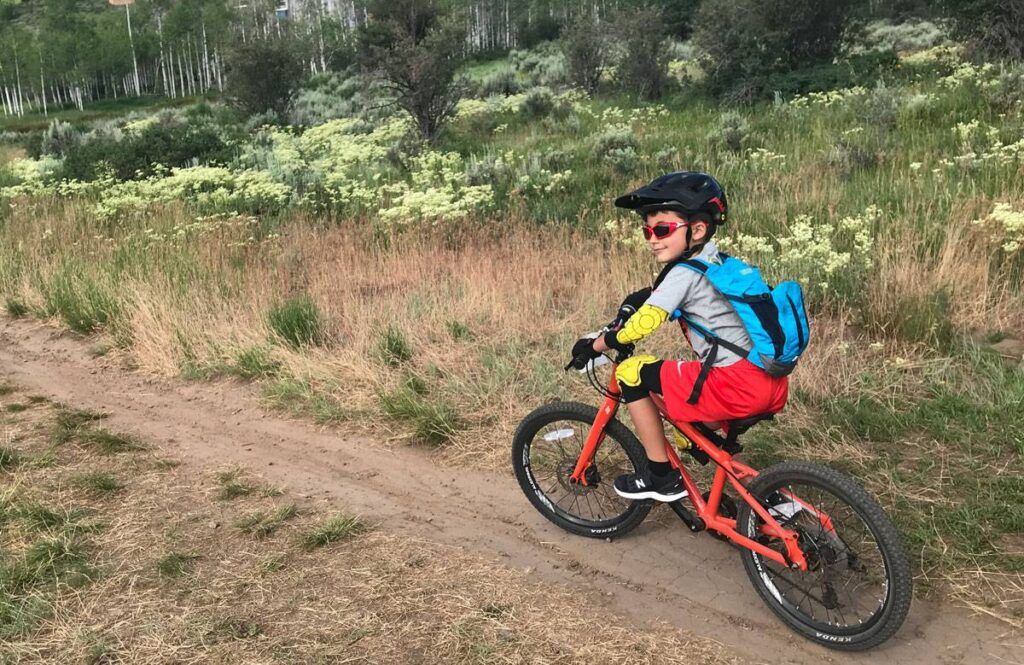
The Pello Rover is available with or without suspension. If you choose to purchase a suspension fork, the rigid fork is also included at no extra charge. Upon checkout, you have the option of having the Rover shipped with the suspension fork installed and the rigid fork in the box, or vice versa.
The optional fork on the Rover, however, is coil and not as responsive as an air fork. As a result, if your child really needs suspension (the vast majority don’t – see our suspension section below for reasons why), you may be better off taking a huge leap in price to get the woom OFF AIR.
| Rover | Rover w/ Suspension | |
| MSRP | $589 | $688 |
| Weight | 20.3 lb. | 22.3 lb. |
| Seat Height | 22.5″ – 27.5 | 22.5″ – 27.5 |
| Tire Width | 1.95″ | 1.95″ |
| Max Tire Width | 2.1″ front, 1.95″ rear | 2.1″ front, 1.95″ rear |
| Gearing | 7 speed, SRAM trigger | 7 speed, SRAM trigger |
| Brakes | Mechanical disc | Mechanical disc |
| Fork | Rigid | 50 mm Coil fork with rebound |
| Head Tube | 69.5° | 69.5° |
| Seat Tube | 72° | 72° |
COMPLETE REVIEW: Pello Rover
The Rover is the goldilocks of 20 inch mountain bikes with just the right amount of technical components for the advancing, intermediate rider. Coming standard with a lightweight, low center of gravity frame, trigger shifters, and mechanical disc brakes, the Rover has everything a young rider needs to tackle blue trails without the added expense of “nice to haves”. As icing on the cake, the Rover comes with a pretty reasonable price tag.
As your child progresses, so can the Rover. In addition to adding a suspension fork, 2.1″ wide, cushioning, knobby mountain bike tires can be added for additional traction and cushioning (an upgrade over the standard 1.95″ all-terrain tires).
So who is the Rover not best for? While we love the Rover for its exceptional performance for a wide array of riders, for lovers of downhill, the downhill stability of a slacker headtube like the woom OFF and Zulu are certainly beneficial.
Prevelo Zulu Three
Downhill Focused Rig with 80mm Air Fork, Tubeless Ready
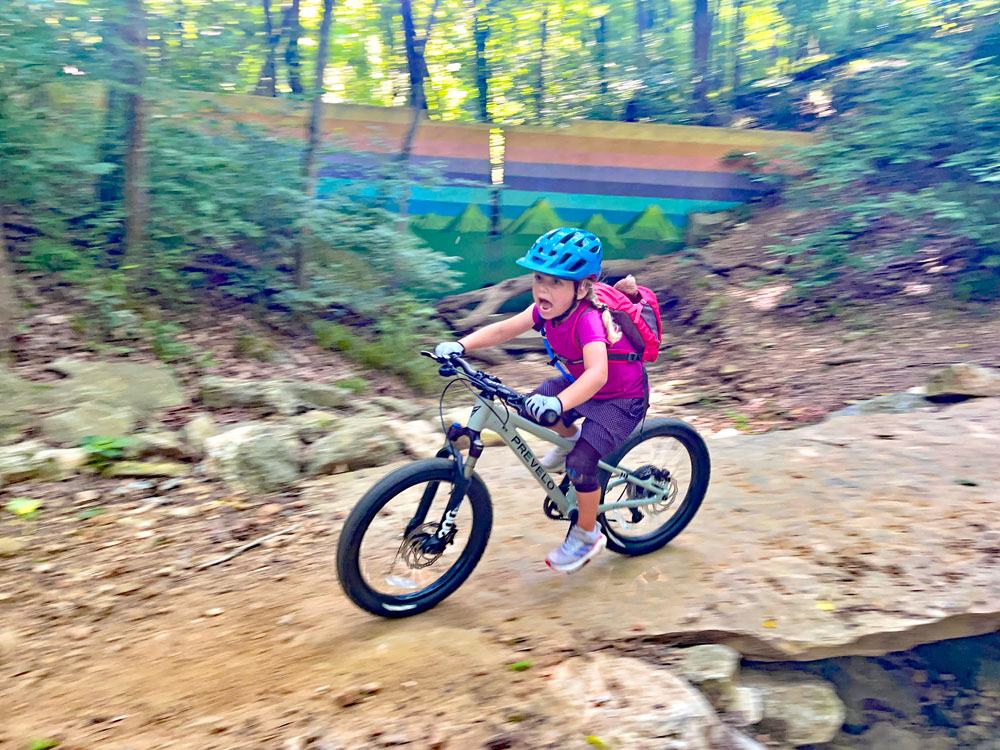
The Prevelo Zulu comes in two models – the Zulu and the Zulu HEIR. Both models share the same frame, drivetrain, and brakes. In order to save on weight, the HEIR steps it up a notch with a more responsive air fork, and is also a few pounds lighter.
| Zulu Three | Zulu Three HEIR | ||
| MSRP | $999 | $1,299 | |
| Weight | 23.9 lb. | 21.1 lb. | |
| Seat Height | 22.8″ – 27.5″ | 22.8″ – 27.5″ | |
| Tire Width | 2.25″ tubeless ready | 2.25″ tubeless ready | |
| Gearing | 9-speed, Microshift trigger | 9-speed, Microshift trigger | |
| Brakes | Hydraulic disc | Hydraulic disc | |
| Fork | Air w/ 80mm travel | Air w/ 80mm travel, adjustable rebound | |
| Head Tube | 66° | 66° | |
| Seat Tube | 74° | 74° |
COMPLETE REVIEW: Prevelo Zulu Three
If you’re lucky enough to have a young grom eager to take on challenging intermediate trails without hesitation, you need the Prevelo Zulu Three in your stable. For true downhill trail riders, you’d be hard-pressed to find a kids 20″ all-mountain bike as well thought out as the Zulu.
With a 66° head tube angle, 835 mm wheelbase, 80 mm of travel on an adjustable air suspension fork, hydraulic disc brakes, as well as dropper post compatibility, the Zulu is incredibly capable on the downhill. Whether plowing through chunky rock gardens or hitting up the jump line, the Zulu confidently holds its line and delivers.
When headed uphill or on generally flat trails with bursts of climbing or descending, the Zulu’s steeper seat tube angle properly places the rider above the pedals to efficiently reward every push of the pedal with plenty of power. While not the most lightweight option, we’ve watched our little rippers dominate the trails with this little pony.
For those aggressive riders keeping it old school and pedaling their way up the mountain, the 2 pound weight savings on the HEIR is a worthy investment
Trailcraft Blue Sky 20
Most Lightweight Hardtail on the Market, Very Customizable
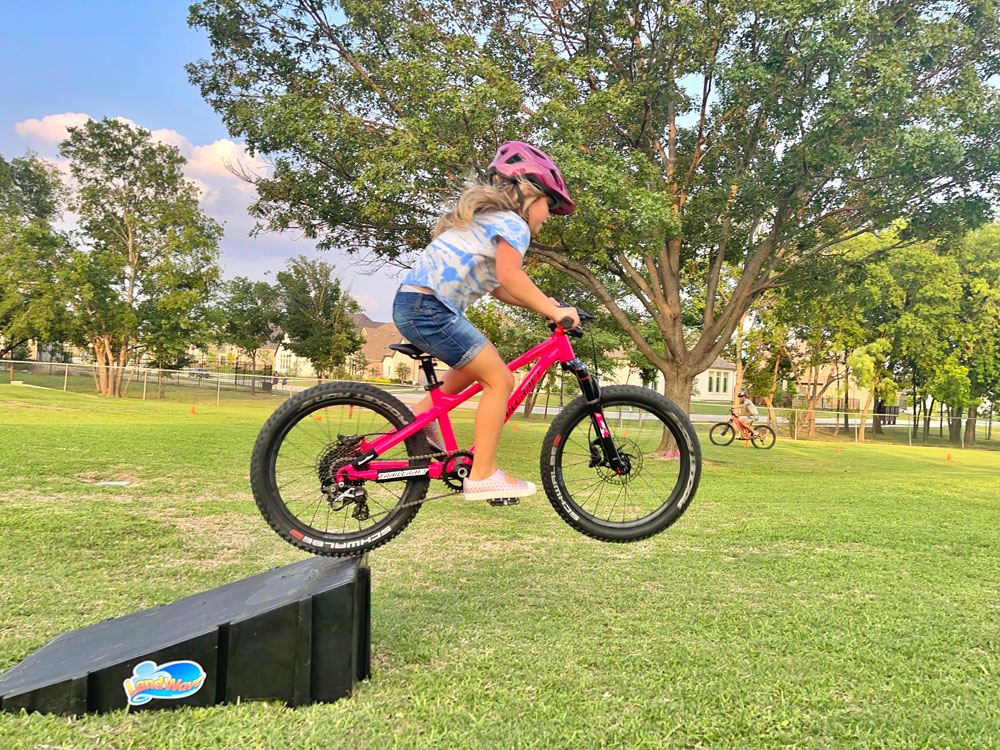
The Trailcraft Blue Sky 20 comes in two different models – the standard Special and the upgraded Pro. The Pro is about 1.5 pounds lighter and has even higher-end components than the Special does.
| Blue Sky Special | Blue Sky Pro | ||
| MSRP | Not available | $1,899 | |
| Weight | 20.5 lb. | 19 lb. | |
| Seat Height | 23″ – 28.6″ | 23″ – 28.6″ | |
| Tire Width | 2.2″ tubeless ready | 2.2″ tubeless ready | |
| Gearing | 10-speed, Microshift trigger | 10-speed, Shimano trigger | |
| Brakes | Hydraulic disc | Hydraulic disc | |
| Fork | Air w/ 80mm travel, adjustable rebound | Air w/ 80mm travel, adjustable rebound | |
| Head Tube | 68° | 68° | |
| Seat Tube | 73° | 73° |
COMPLETE REVIEW: Trailcraft Blue Sky 20
There are two primary reasons to spend so much more on a Trailcraft bike – low weight and customizability. How much those two things are worth to you is up to you.
The Pro build of the Blue Sky is two pounds lighter than the woom OFF AIR. While two pounds doesn’t seem like a lot, for a 5 year old climbing hills, that can make a big impact on their desire and ability to keep pushing. We will say that the difference was noticeable for our 5.5 year old aggressive tester, and did make a positive impact.
If you’re picky about component selection, Trailcraft is the kids’ brand for you. Besides being able to choose chainring size as well as drivetrain and braking component levels, all Blue Skys come taped for tubeless conversion, and can even be shipped to you already converted. Dropper post compatibility is also standard.
And if the component offerings Trailcraft has on their site don’t work for your dream build, you can work with the owners to customize that bike even further. As a super small, custom shop, they have the ability to tweak your order in ways that the other brands can’t.
20 Inch Mountain Bikes to Keep on Your Radar
Not every bike can make our top 10 list, but are still worthy options.
Cleary Owl
Vibration-absorbing steel frame, extremely durable

The Cleary Owl comes in two models – a single-speed and a 3-speed. The models are otherwise identical.
| Owl | Owl 3-speed | |
| MSRP | $430 | $500 |
| Weight | 20.3 lb. | 22.6 lb. |
| Seat Height | 20.5″ – 26.1″ | 20.5″ – 26.1″ |
| Tire Width | 1.9″ | 1.9″ |
| Max Tire Width | 2.125″ | 2.125″ |
| Gearing | Single | 3-speed, trigger |
| Brakes | V-pull | V-pull |
| Fork | Rigid | Rigid |
| Head Tube | 70° | 70° |
| Seat Tube | 71° | 71° |
COMPLETE REVIEW: Cleary Owl
Built on a durable, vibration-absorbing steel frame, the Cleary Owl is built like a tank, yet moves with the precision and delicacy of a rally car. Our testers all loved the nimble feel of the Owl, while their parents loved the durability and heirloom quality.
Both Owl models come with 1.9″ wide tires, but the tread is pretty smooth. For those who want to hit the trails, Cleary offers and recommends the extra-grippy, off-road Schwalbe Black Jack tires directly on their site.
If hills and elevation gains are in your future, the Cleary Owl 3-speed offers an extra-low gear for heading up and a high gear for heading down. To keep things clean and easy, the gears of the Owl are securely tucked in the bike’s rear hub, so there’s no finicky derailleur to worry about!
The trigger shifters on the Owl, however, were more challenging for our young riders to use than other brands, but certainly wasn’t a deal-breaker.
Decathlon Rockrider
Rare Quality of Performance and Build at a Low Price Point
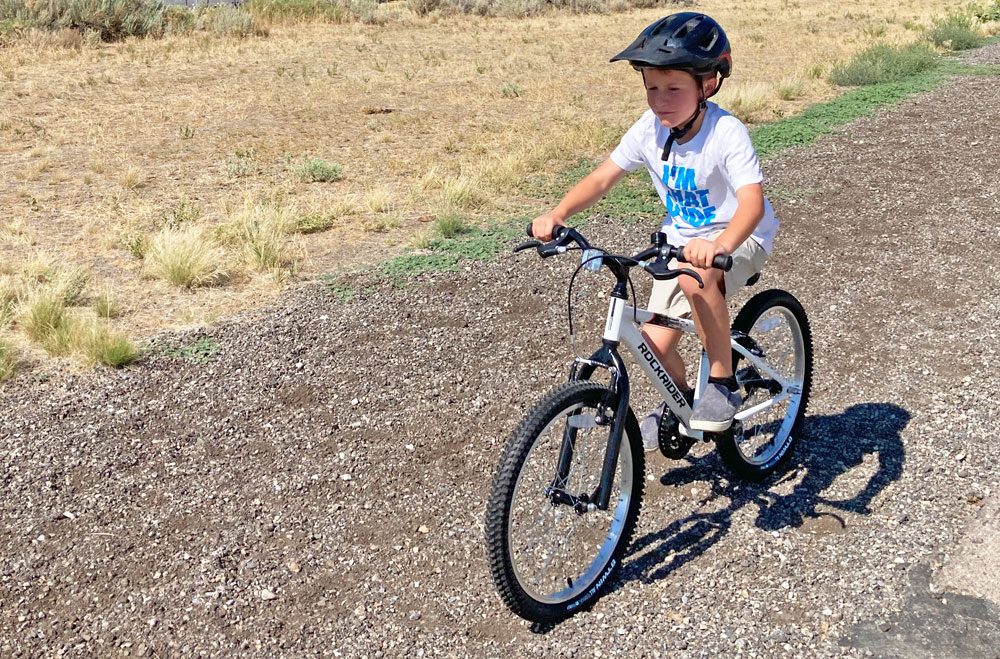
If you are on a tight budget, Decathlon’s Rockrider series is by far the best budget 20 inch mountain bike on the market and hands-down better than any similarly-priced bike you’ll find at a big-box store. The Rockrider comes in three models. All three models have the same frame design and fit the same size child, but vary in components.
We have only seen the ST100 in person, but based on our experience with all of Decathlon’s bikes, we’re confident the other models will offer great value and performance for their price points.
| ST100 | ST500 | ST900 | |
| MSRP | $99 | $229 | $200 |
| Weight | 24.3 | ||
| Seat Height | 23.3 – 30.3″ | ||
| Frame | Steel | Steel | Aluminum |
| Tire Width | 1.75″ | 1.95″ | 2.0″ |
| Gearing | Single speed | 6 speed, Microshift grip shift | 6 speed, Shimano grip |
| Brakes | V-pull | V-pull | Mech. Disc |
| Fork | Rigid | 40 mm Coil | 40 mm Suntour Coil |
While the basic single-speed Decathlon Rockrider ST100 is just that – basic – it is the only bike in its price range that does a phenomenal job at basic.
From frame design to quality of build, the Rockrider certainly doesn’t act or ride like a budget bike. Unlike most budget bikes (like those found at Walmart or Target), the v-pull rim brakes on the Rockrider offer responsive braking power straight out of the box.
If you are able to extend your budget, the ST500 and ST900 models offer 6 gears as well a suspension fork. The suspension fork and drivetrain do add a couple of pounds to the weight, however. To compensate, the ST900 does have an aluminum frame versus a steel frame (weights on these models forthcoming).
COMPLETE REVIEW: Decathlon Rockrider 20″ Review
Cleary Scout 20
Rugged and usually on sale

| Cleary Scout 20 | ||
| MSRP | $980 | |
| Weight | ~24 lbs. | |
| Seat Height | TBA | |
| Tire Width | 2.25″ | |
| Max Tire Width | TBA | |
| Gearing | 10-speed trigger | |
| Brakes | Hydraulic Disc | |
| Fork | Suntour 80MM travel air | |
| Head Tube Angle | 68.5° | |
| Seat Tube Angle | 73.5° |
The Cleary Scout got a major overhaul in 2022. Now the Scout has been completely redesigned – aluminum frame (instead of steel), new geometry, upgraded components, and now also offered in a smaller 20″ version.
We haven’t had a chance for our little rippers to rip on it yet, but have received feedback that the Scout is heavier than other bikes on this list. If you can find it on deep discount (it’s often 50% off!), the added pounds might be worth the savings for you.
20 Inch Mountain Bikes we DON’T RECOMMEND
Just because a kid’s bike is made by a brand you respect doesn’t mean it’s the best option for your child. The bikes below are solid-quality rigs, but there are better mountain bikes for near the same price.
Specialized Riprock 20
Very Aggressive Geometry for Young Rippers
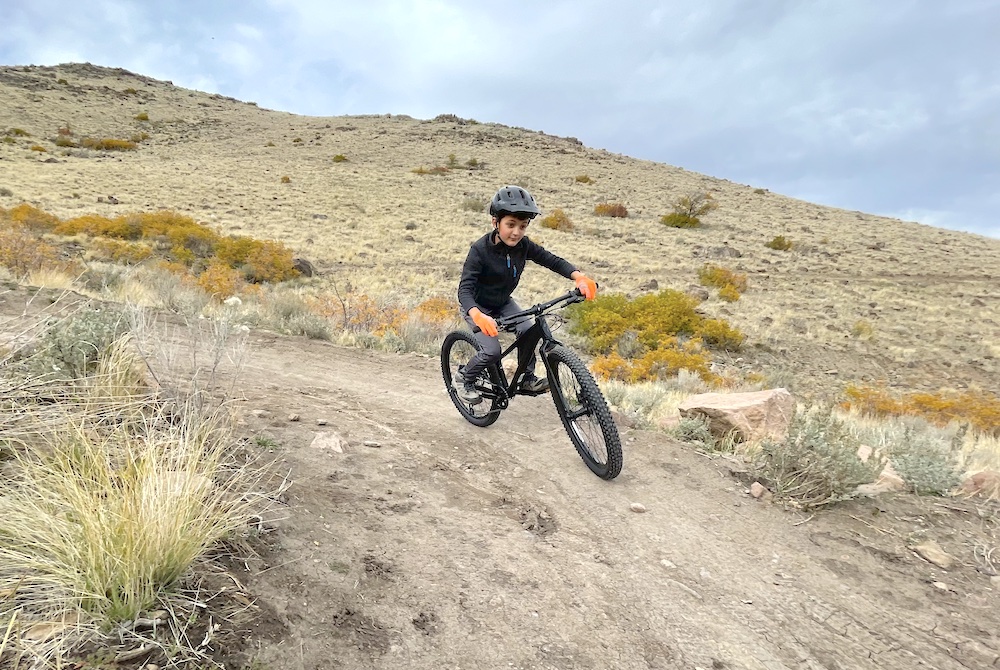
The new 2022 Specialized Riprock is only available in one model and it is not available with a suspension fork. The 24″ Riprock, however, does have a second Riprock Expert model that includes a suspension fork.
| Specialized Riprock | ||
| MSRP | $599 | |
| Weight | 22.2 lb. | |
| Seat Height | 25″ – 30″ | |
| Tire Width | 2.35″ | |
| Max Tire Width | 2.35″ | |
| Gearing | 9-speed trigger | |
| Brakes | Hydraulic disc | |
| Fork | Rigid | |
| Head Tube Angle | 68° | |
| Seat Tube Angle | 73.5° |
COMPLETE REVIEW: Specialized Riprock 20 and 24
Completely updated and redesigned for 2022, the new Specialized Riprock is a fast, fun, and ambitious pony for the most aggressive riders. But while the Riprock boasts impressive components with its hydraulic disc brakes, trigger shifters, as well as 2.35″ wide, cushioning tires, its overly aggressive geometry is a bit puzzling.
The Riprock 20’s low stack height, extra-wide handlebars, minimal-rise stem, and high seat placement combine to make a very narrow window of good fit. We are hoping to see a re-work of the Riprock’s geometry in its next update, but until then, it’s difficult to recommend. Be sure to read our full review for images and a more detailed explanation if you’re curious!
But for those aggressive little groms whom the Riprock does fit, it is sure to deliver a fantastically addictive ride. Even without a suspension fork, when lowered to the proper PSI, Specialized Ground Clearance tires provide plenty of cushioning and traction for chunky rock gardens and small drops.
Trek Precaliber 20 7-Speed
Heavy for its price range
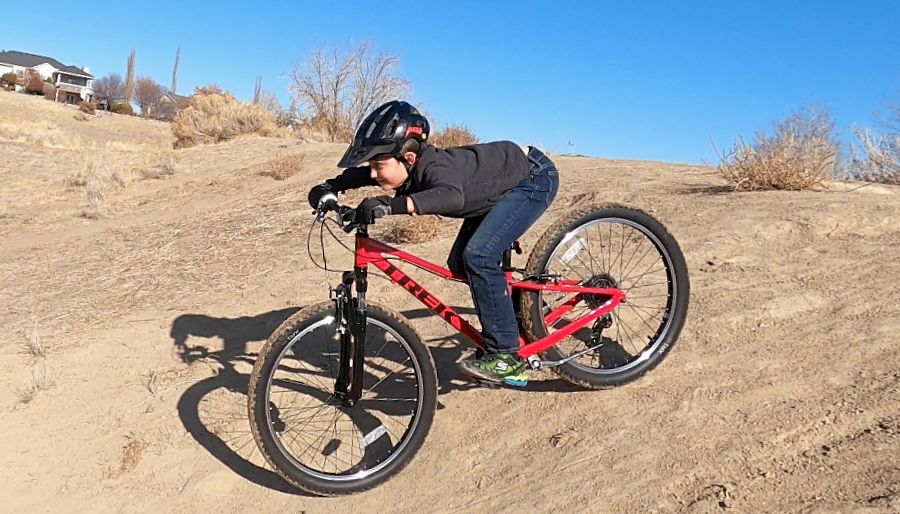
COMPLETE REVIEW: Trek Precaliber Kids Bike Review
The Trek Precaliber is a solid-quality pony for kids who need a multi-use bike for the neighborhood and basic dirt trails. But if you really want to develop your child’s mountain biking skills, there are better options for a similar price. Grip shifters are not ideal for mountain biking, and the Precaliber is heavy for its price.
If you were considering this little Trek because of its price point, we suggest going with the Polygon Premiere. It’s 4 pounds lighter, $100 cheaper, and has the same or better components. However, the Polygon also has a grip shifter.
If you’d like to upgrade to trigger shifters (which we highly recommend for mountain biking!), check out the Prevelo Alpha Three. While more expensive, it’s considerably lighter and has better components.
REI Co-Op REV Plus 20
Heavy for its price range

COMPLETE REVIEW: REI Co-Op Cycles REV Kids Bikes
This is another bike that we love for many reasons, but don’t think it’s great for true mountain biking. While it looks like a pretty sweet rig with those mid-fat tires, the bike is heavy – 25 pounds. And that’s without a suspension fork.
While you certainly could mountain bike with the REV Plus 20 if that’s what your budget allows, most kids would be better off on the lighter and cheaper Polygon Premiere (20.75 pounds). Or if you can spring an extra few hundred dollars, you’ll get trigger shifters on the Prevelo Alpha Three (19.1 pounds) or Commencal Ramones 20 (23.5 pounds).
What to Look For When Choosing a 20 Inch
Mountain Bike
20 inch mountain bikes are unique in that they are still very much a “kids bike”, yet need to perform like an adult bike. Simply taking an adult mountain bike and scaling it down to kids’ proportions sounds simple in principle, but can quickly lead to disaster in the application.
Not only are kids’ body proportions different than an adults’, kids weigh significantly less. As a result, the weight of a bike cannot be overstated in the cost-benefit analysis of every component on the bike.
On most adult mountain bikes, you want ALL the features because their added weight is pretty insignificant when compared to functionality. But with small mountain bikes, the opposite is usually true. Weight is king and optional components (ie. suspension fork, dropper post, etc.) should be added with caution.
So from tires to brakes, we’ll walk you through what you truly need and what you can skip when choosing a mountain bike for your son or daughter.
Weight
As stated above, for young riders hitting the trails, a lightweight bike is imperative. While older, heavier, and more experienced riders can handle heavier bikes, most kids on 20 inch mountain bikes don’t fit any of those descriptions. So for 20 inch riders, oftentimes lightweight basic trail bikes are better for getting started than more advanced bikes.
For example, with our 6-year-old child who weighs 50 pounds, the 24 pound REI Co-Op Plus amounts to 48% of his body weight. We have tested the Co-Op bike (and loved it!), but even though it has wide off-road tires and disc brakes, it was too heavy for practical use on any longer trails with climbs. On the same trail, however, the 19 pound Prevelo Alpha (38% of his body weight), did much better even though it has much narrower all-terrain tires and V-brakes.
So even if you dream of your little one bombing down legit trails on a mini-enduro style 20-inch bike, we highly recommend getting them started on a lightweight bike with fewer features first… and then moving them up to a more advanced bike when ready. In addition to helping them to better learn the technical aspects of riding, it will also ensure your little one really is ready to handle a more aggressive (and MUCH more expensive) rig.
Tires

The best tire for your child’s bike really depends on the terrain they are riding. While wider, off-road tires are typically better for mountain biking, they aren’t always the best fit for every rider.
Beginning riders often do just fine on a quality all-terrain tire such as the popular Kenda Small Block 8 found on the Prevelo Alpha and Polygon Ultralight. We have had several testers successfully complete mountain bike classes on Small Block 8’s without any issues. Due to their lower rolling resistance and lighter weight, the Small Block 8’s helped keep things light and nimble on the climbs while still providing plenty of traction on the downhill.
Once our testers really learned to lean aggressively into turns or even take on choppier trail sections at speed, the extra cushioning benefits of wide, beefier tires are well worth the upgrade. When set to a lower PSI, wider tires on a 20″ MTB can provide the same cushioning effect as some suspension forks.
For our fast-growing kids, those tires came in the form of a larger 24″ bike (kids can outgrow 20″ bikes very quickly!), but for our smaller riders, we simply swapped the tires on the 20″ bike to a wider, knobby tire, such as these 1.9″ Schwalbe Black Jacks.
Suspension Fork
Although a very unpopular opinion, over the years we have found that the vast majority of kids on 20 inch mountain bikes will do better on a rigid bike than a bike with suspension. Why? The added weight of the suspension fork often does more harm than the slight benefits of the suspension fork.
Kids on 20 inch bikes don’t weigh much, so a suspension fork must be fine-tuned to properly handle the minimal variances in pressure applied to the fork by featherweight kids. In the past, these forks simply didn’t exist. Suspension forks on 20-inch bikes were just for show.
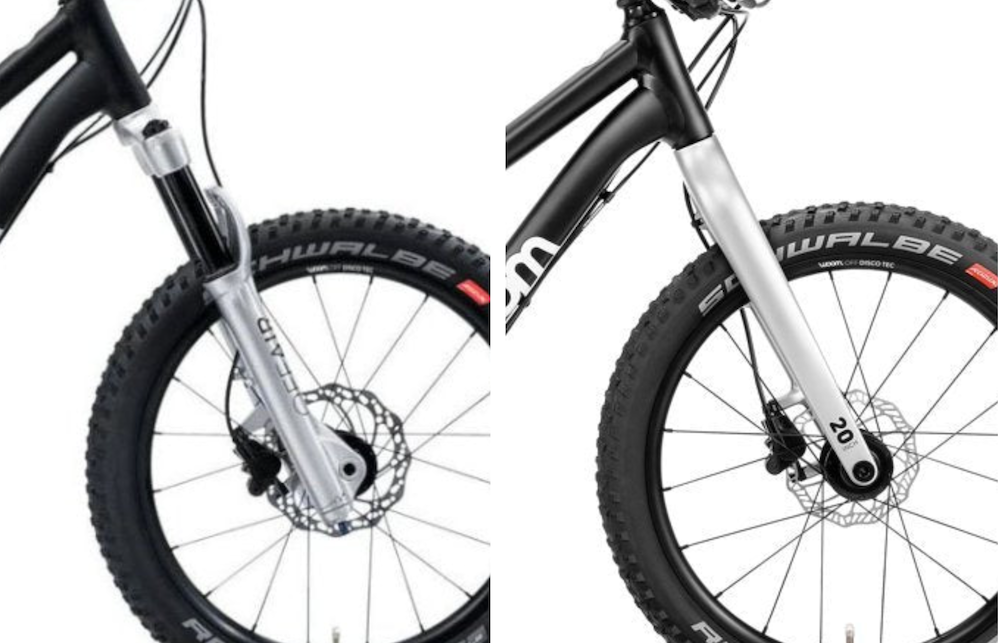
In recent years, several quality forks have been developed for young kids, but they are VERY expensive. In almost all cases, it is better to put your money towards a rigid lightweight bike with wider cushioning tires (set to a low PSI) rather than a bike of the same price that is heavier and has front suspension.
Reasons to get a 20 inch mountain bike with a suspension fork:
- Your child is riding long or hard enough on rough terrain that their hands or arms are getting numb
- Your child’s bike can’t fit extra wide 2.1″+ tires set at a low PSI (especially the front tire). Wide cushioning tires on 20″ MTB often provide the same cushioning effect as most suspension forks.
- Their rides are mainly downhill (shuttle rides, lift assist, lots of tow rope)
- AND (not OR) You have the budget to buy a high-end bike ($900+) with a quality suspension fork.
Reasons you should NOT get a 20-inch mountain bike with a suspension fork:
- You think they need one (versus the child demonstrating the need).
- Because they look cool.
If you aren’t sure if your young grom needs a suspension fork or not, we highly recommend going with the woom OFF or the more affordable Pello Rover. The Pello Rover with suspension also comes with a rigid fork. As a result, you can start your little shredder off with the rigid fork and move them up to the suspension fork once they have shown the need. Unlike the air fork of the woom, however, the suspension fork on the Rover is coil and not as responsive.
While the woom OFF AIR does not come with the rigid fork, the suspension fork for the woom OFF can be purchased separately as an upgrade later down the road.
Gears or Single Speed?
Unless you plan to only hit small dirt trails around the neighborhood, shuttle basic downhill rides (aka dropped off at the top and just ride down), or just stick to laps at the pump track, your child’s 20 inch mountain bike needs to have gears.
6 gears should be your minimum for true trail riding, but if lots of elevations gain are in your future, the wider gearing range the better. Regardless of how many gears you land on, for any 20 inch mountain bike, we also highly recommend picking up a tow rope! From long ascents to hangry kids, tow ropes are a must for any mountain biking family.
Trigger vs. Grip Shifter
For aggressive riding, trigger shifters are always better. In addition to being easier to quickly shift, they prevent kids from accidentally tweaking the bike’s handlebars as a result of shifting too hard.
As your child progresses, many bikes with grip shifters can fairly easily be switched over to trigger shifters. You’ll just need to purchase a trigger shifter that matches the number of gears on your bike, such as this 7-speed trigger shifter, as well as new grips. This bike mechanic’s video does a great job of showing the conversion process.

Compared to grip shifters, trigger shifters can be confusing for younger kids to learn how to shift. To help kids learn, we highly recommend placing colored stickers on the trigger shifter levers. To teach them, ride behind them and coach them when to shift by calling out the color of the button they should push.
Brakes – Do you need disc brakes?
All mountain bikes need to have high-performing, reliable brakes with plenty of stopping power. If your rider is sticking to basic trails (green trails), high-end v-pull brakes are just fine. As your child progresses to intermediate trails (blue trails), the extra stopping power of disc brakes is worth considering.
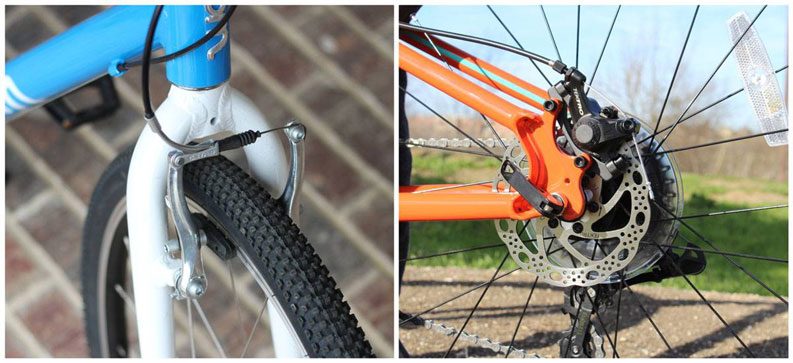
Hydraulic disc brakes are the cream of the crop as they allow kids to modulate their braking (i.e. slightly brake by slightly pressing on the lever) and also prevent hand fatigue. Mechanical disc brakes offer more stopping power than v-pull rim brakes, but don’t have the modulating power of hydraulic disc brakes.
Mechanical disc brakes can be upgraded to hydraulic disc brakes pretty easily, but in most cases, it isn’t possible to upgrade a bike with v-pull brakes to disc brakes.
Geometry
The best geometry for your kid’s 20 inch mountain bike really depends on how much climbing is in your child’s future. Kids on 20 inch bikes are really in that awkward spot where they don’t need to be towed up every trail (like those on 16″ bikes), but they still don’t have the stamina and muscle strength to power all the way up trails like older kids on 24’s.
While you certainly can (and should at times!) tow your child up a trail, you also want to give them the opportunity to learn how to climb as well as build their physical and mental endurance. As a result, we believe that for most kids, 20 inch mountain bikes with less aggressive 68° – 70° head tubes are ideal.
That is not to say that slacker bikes (66° – 67° head tubes) that are designed for the downhill don’t have a place. For those experienced young riders who have the desire to power through the uphill to earn the sweet reward of the downhill, slacker bikes are the perfect ride. If shuttled rides or lift-assist rides are also on your radar, you can’t go wrong with a slacker 20 inch mountain bike.

What is the head tube angle (HTA) of a bike? The head tube angle of a bike plays a major role in how far forward the front tire is positioned in front of the bike. The more forwardly positioned the front tire, the “slacker” the bike. The closer the front tire to the bike, the “less slack” the bike is.
Due to the unique challenge of fitting a small kid’s body onto a bike with modern geometry, bikes that are considered “slack” for a 20 inch are a bit different than for adult bikes. After comparing all the major kids brands of bikes (including Spawn, Trailcraft, Specialized, Commencal, Prevelo, woom, etc.) the slackest head tube angle we found was the 66° on the Prevelo Zulu. 68° was by far the most popular head tube angle, while “all-arounders” were 69° or 70°.
The reason we prefer mountain bikes with higher head tube angles is that they make climbing easier. On “slacker” bikes, the more forward-positioned wheel allows less of the rider’s weight to be on the front wheel. As a result, during steep climbs, the front tire can begin to “slip” if the rider doesn’t lean forward to put additional weight on the wheel.
While adult riders quickly learn to lean in while climbing, young riders are often focused on so many other things that they don’t remember to lean in enough. Bikes with “less slack” head tubes position the bike’s front tire closer to the bike, so more of the child’s weight is automatically placed over the front tire.
Girls and Boys 20 inch Mountain Bikes
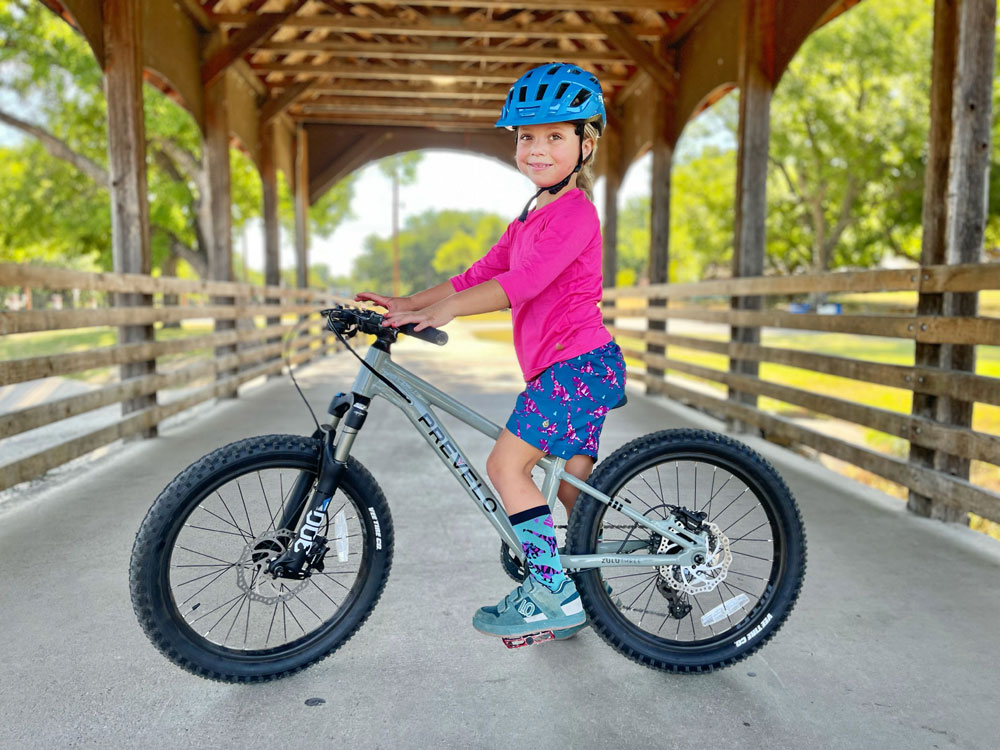
Is a girls 20 inch mountain bike different than a boys 20 inch mountain bike? Nope. All kids mountain bikes are gender-neutral. A child’s skill level and weight are much better factors for selecting the best bike for them rather than their gender. Some brands offer more traditionally feminine color options like pink or purple.
You could also just deck your Rippette out in some sweet SHREDLY MTB gear for girls (seen above).
